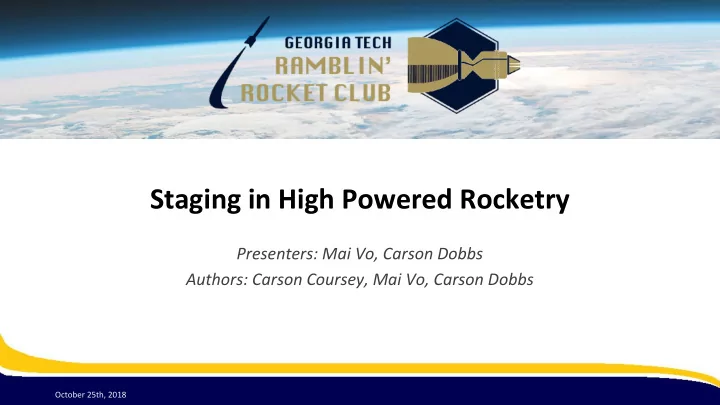

Staging in High Powered Rocketry Presenters: Mai Vo, Carson Dobbs Authors: Carson Coursey, Mai Vo, Carson Dobbs October 25th, 2018
What is staging? 1/16
Why use multiple stages? • Makes rocket more efficient Gets rid of inert mass o Saves fuel o • Makes rocket able to go higher Without the extra mass, rocket is able to go further o Use the fueled saved to go higher o • It’s cool 2/16
Types of Staging Inline Staging (Single Sustainer) • Vertically stacked boosters and sustainer • Each booster is discarded after motor burnout Parallel Staging (Single Sustainer) • Similar to Air Starting • Boosters are externally attached to the sustainer • Each booster separates from the sustainer after its motor burns out Parasite Staging (Multiple Sustainers) • Similar to Air Starting • Sustainers are externally attached to the booster • Each sustainer separates after booster burn out 3/16
Inline Staging • Used in most projects of this type, as well as projects at the highest level: Saturn V, F9, etc. • Staging type we’ll most likely go with It’s the most common for HPR o It’s the most applicable for our objective o Nobody has said anything about a different type o of staging 4/16
Difficulties of Staging • 2 of Everything (ignitions, separations, recovery devices,... rockets) o • Separation Structure required o Separation implement o Timing o • Ignition Air start o Delay o Altitude calculations o 5/16
Phases of Staged Flight 1. Booster Ignition - Typical 2. Booster Ascent - Typical, more complex 3. Coast + Separation - New 4. Sustainer Ignition - New 5. Sustainer Flight - Typical 6. Recovery - Typical, more complex Image and info from UAH SHC rocketry report 6/16
Separation - Required Components • Interstage Structure • Coupler • Black powder charge/CO2 Can • Shear pins • Possible avionics bay in the interstage • Some sort of nozzle cap or “Piston” that comes off during sustainer ignition 7/16
Separation Solutions • UAH - 3D Printed Interstage w/ shear pins Blue is interstage structure ejected via o black powder White “piston” comes off during sustainer o ignition Red is boat tail fairing, attached to centering o rings 8/16
Separation Solutions 2 • Princeton - Aluminum Interstage Highly load bearing o Slip fit to sustainer motor o Seemingly ejection by sustainer o ignition 9/16
Ignition - Air Start • Possible Failures: Stage ignition failure o Late stage ignition o Coupler malfunction o Early, late or no deployment o • Difficulties Not on launch rail o Electronic Accuracy o Ignition delay (later slides) o 10/16
Ignition - Air Start • Required Hardware Standard avionics hardware (battery, accelerometer, computer, o timer) Ignition hardware (e-match, motor igniter) o • Solutions Most projects seemed to not have much info on how to air start o Simple timed ignition from the avionics o Most likely varies based on design choices, altitudes, etc. o 11/16
Ignition - Altitude Calculation • Closely tied to Ignition Delay • Time the sustainer ignition so that high velocity is maintained for a vertical flight. • Ignition at too low of a velocity will cause the sustainer to drift and ignite the motor in a non-vertical direction. Velocity starts decreasing upon stage separation, so the sooner ignition begins, the straighter the sustainer will fly. • However, if coast is prolonged, the sustainer is able to reach higher altitudes. 12/16
Ignition - Delay • How long the sustainer coasts before ignition will have a measurable effect on our apogee • There is a sweet spot that can be determined by running simulations (RASAero, etc) to achieve 30,000 ft • All that would need to be changed to put in the correct time would be the code/timer 13/16
Useful Links • http://space.uah.edu/assets/files/manuscript_Hunter_04267 .pdf • http://rocket.gtorg.gatech.edu/files/slides/Staging_Clusterin g_and_Complexity.pdf • http://s605282183.onlinehome.us/wp-content/uploads/201 6/01/Staging-Air-Starting.pdf • https://www.rocketryforum.com/threads/need-help-with-hi gh-powered-staging.57697/ 14/16
Useful Links • https://www.rocketryforum.com/threads/so-maybe-ill-try-a- three-stager.66850/ • http://www.spaceportrocketry.org/Motor%20Staging.html 15/16
The End. 16/16
Recommend
More recommend